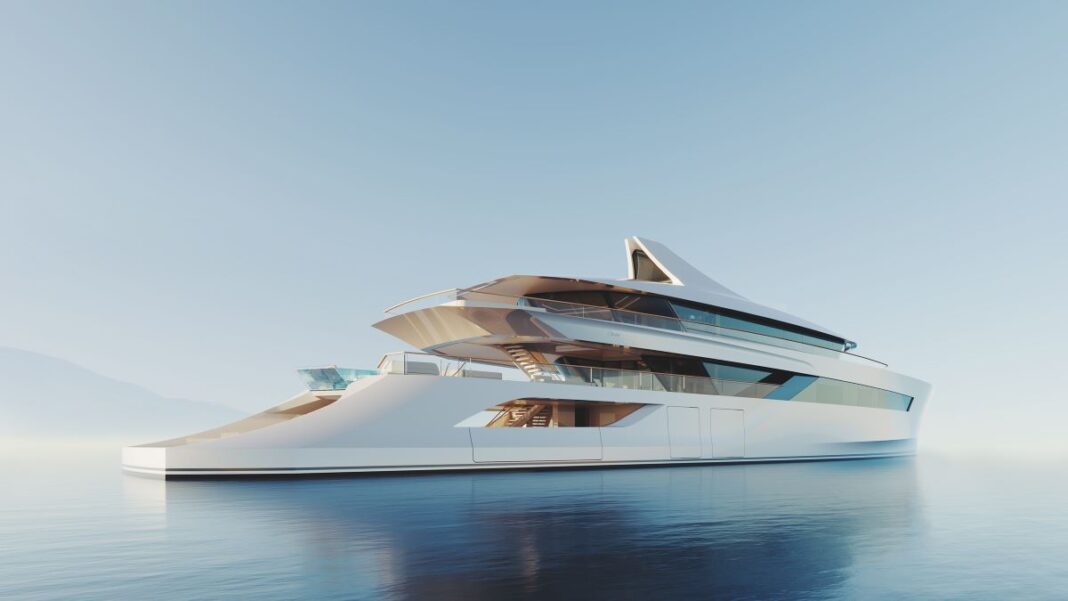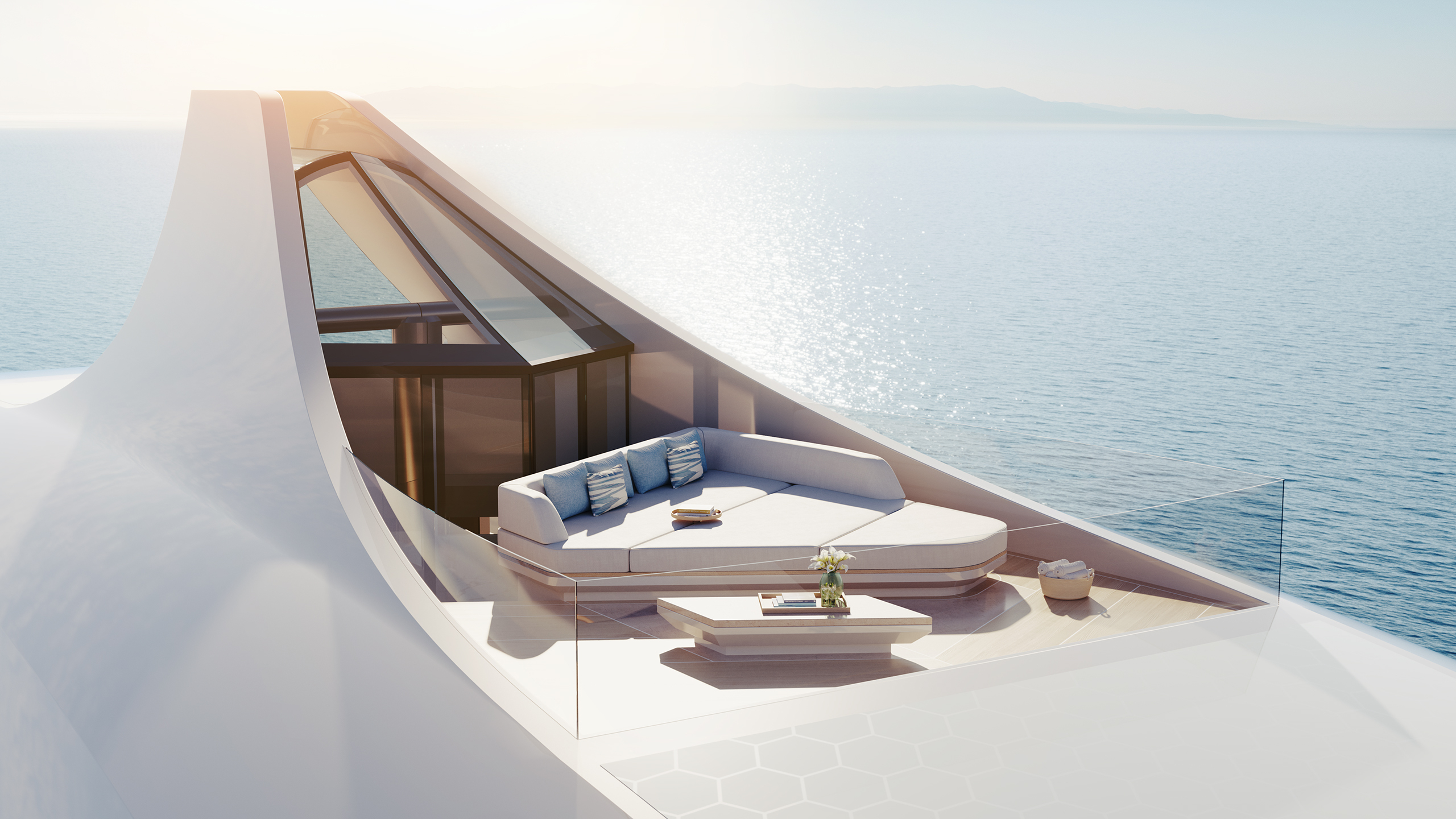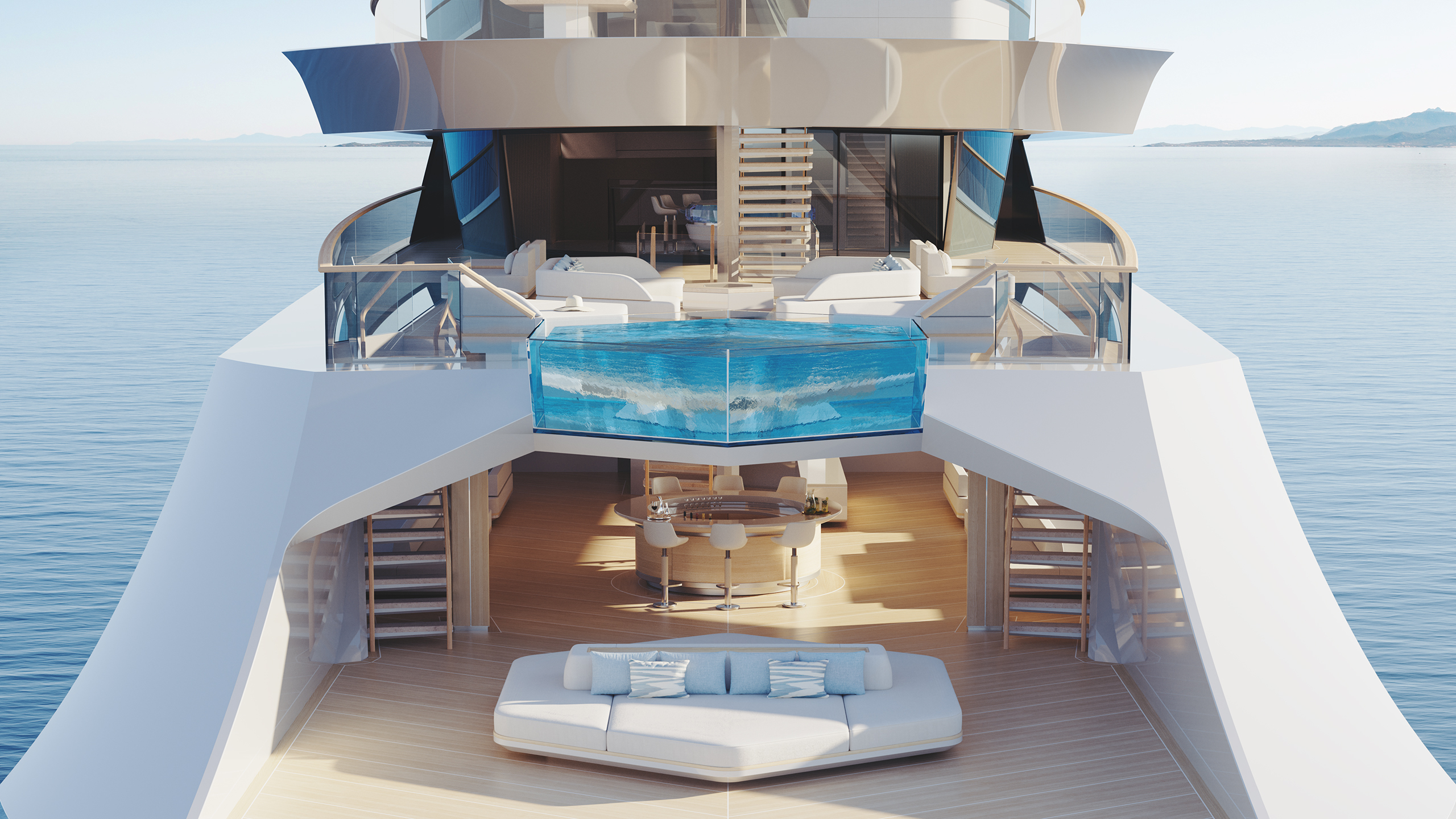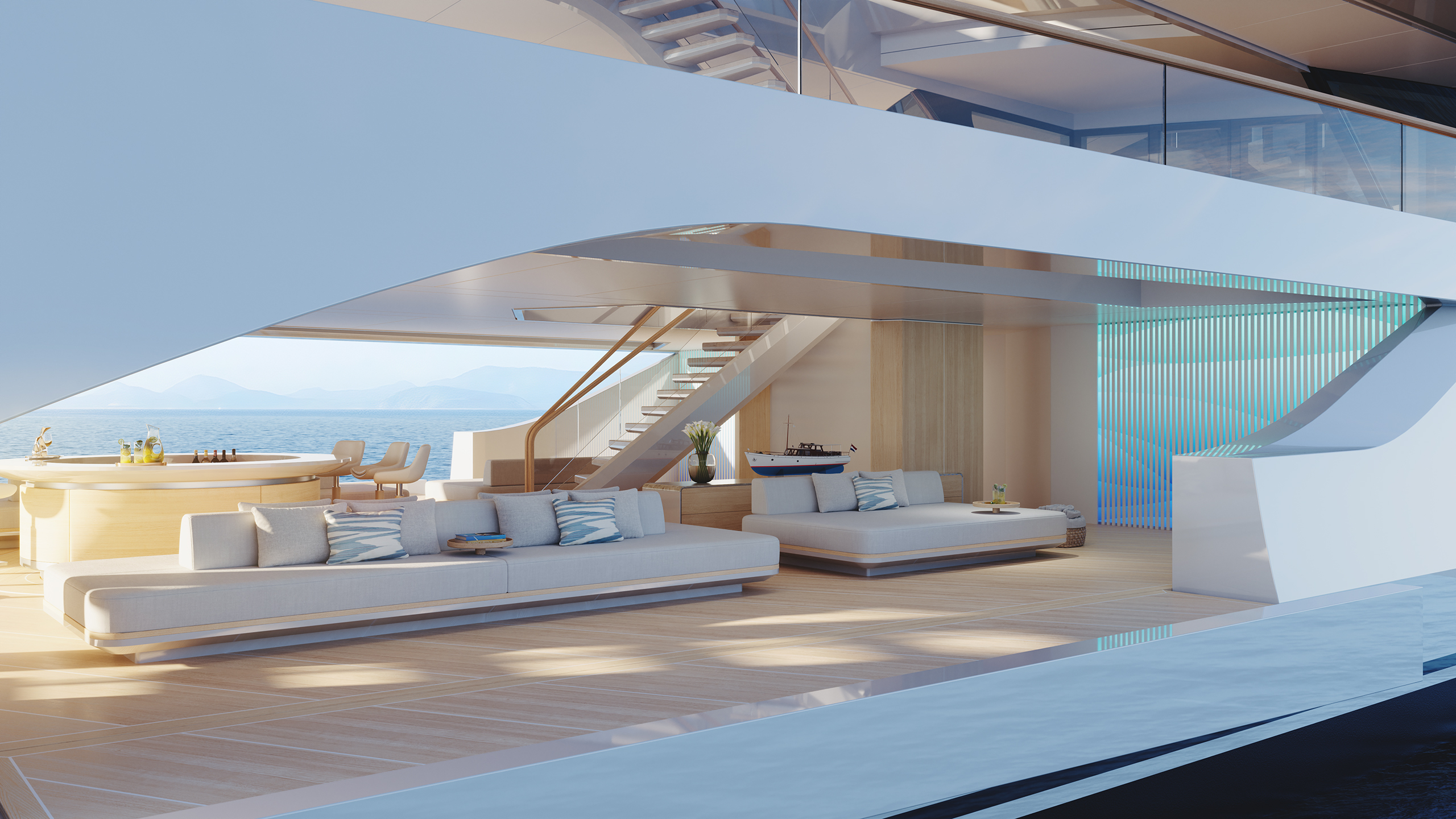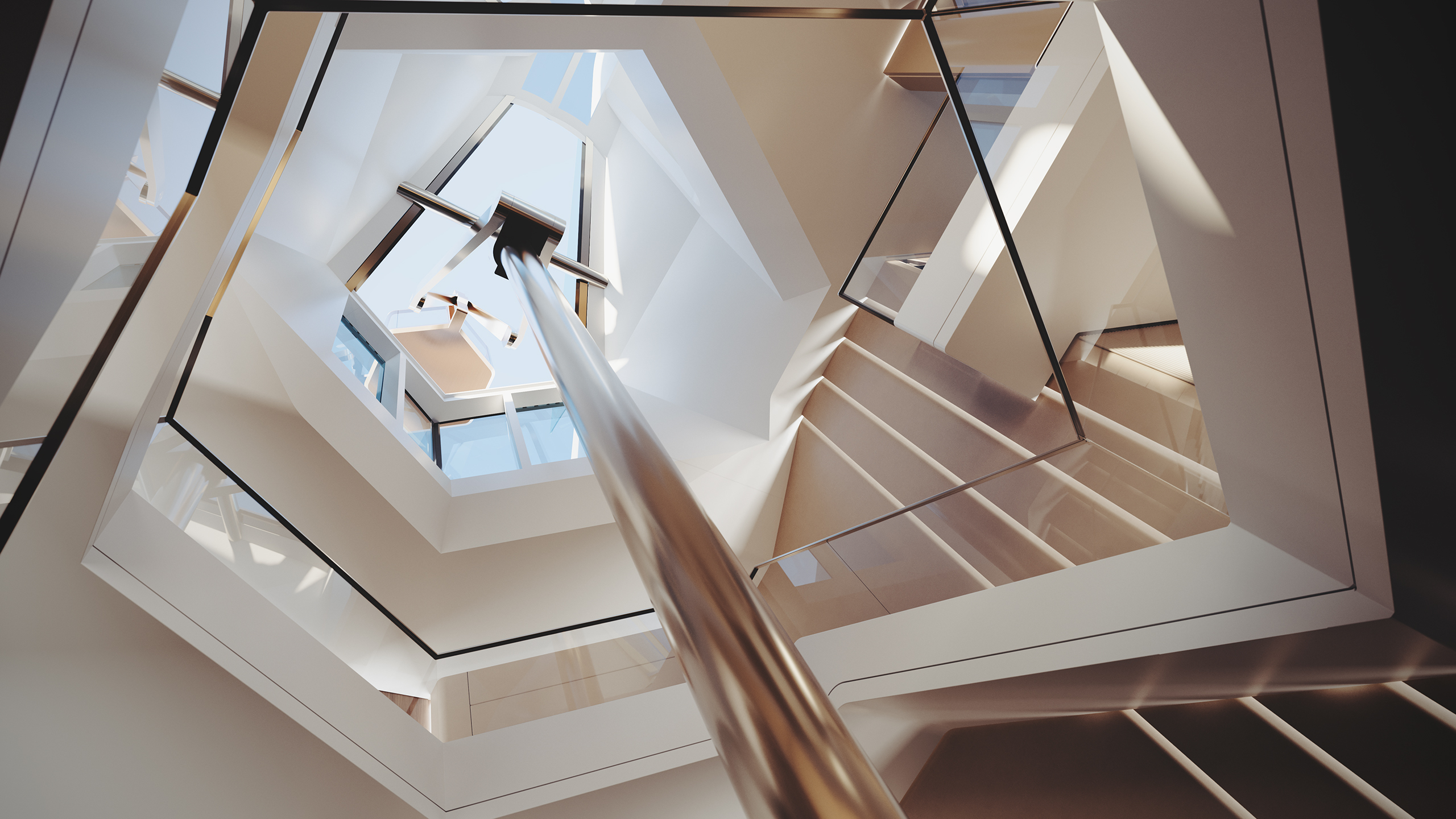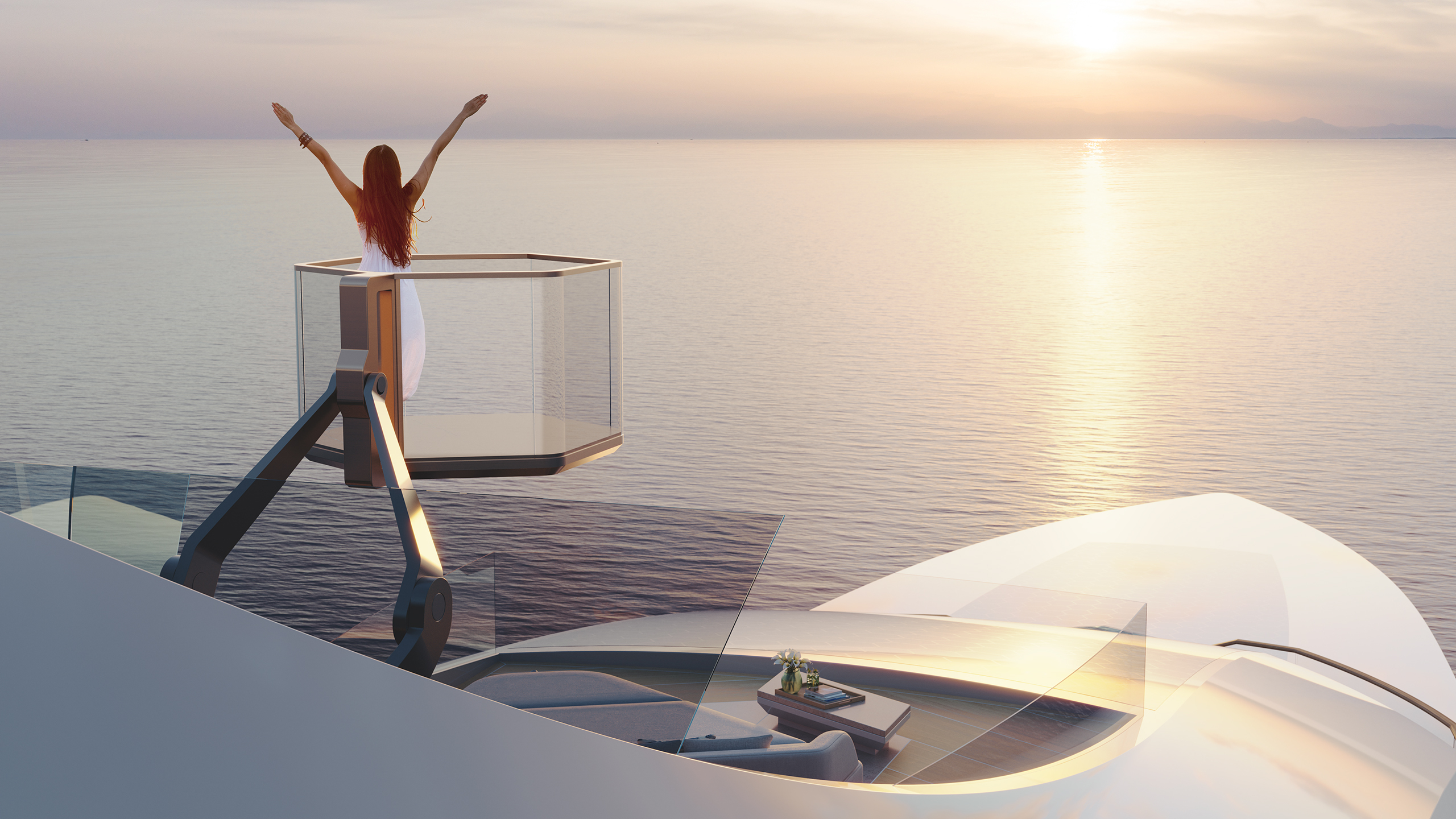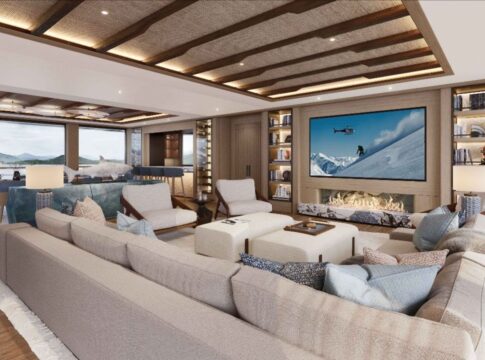One of the most anticipated moments of the annual Monaco Yacht Show is the unveiling of Feadship’s latest concept design.
Compelling and scintillating, brilliantly reflecting the past and projecting the future, Feadship presents concept C. This multifaceted proposal engages the 75-year heritage of Feadship ideals yet advances cutting-edge technology amid glimpses of avant-garde design.
Much more than renderings, Feadship concept designs showcase innovative systems and technologies within a stunning exterior styling and forward-looking interior design. In honour of the Diamond Anniversary of the launch of the Feadship brand, Studio De Voogt named its latest gem “C”.
The name was chosen from the symbol for carbon on the periodic table of elements, carbon being the basis of diamonds – the symbol of a 75th anniversary – and a little play on words see and sea.
C’s matrix is contained by a 75 metre LOA and a requirement that the yacht continues on Feadship’s quest for sustainability, while her flared bow pays homage to the designs of the late Frits de Voogt, whose powerful and iconic bows are evident in the classic Feadships.
If the annual Feadship concept design question is “what can we do better?” C demonstrates the answer in a yacht that brings a dazzling approach to life on the sea and evokes a sense of wonder.
As brilliant as her inspiration, C sparkles with innovations and dazzles with mesmerizing angles. But more than just generating an unforgettable profile, these facets amid broad expanses of glass draw light deep into the yacht’s multi-level interior, turning the centre of circulation for owner and guests into a light-filled gallery and unprecedently fluid living space.
Leading this year’s Concept Design team, senior designer Ruud Bakker shared the inspiration for the 2024 concept, which included experiencing the Amsterdam diamond cutting workshop of Gassan Diamonds to learn how the facet patterns draw light into the stone, reflecting and magnifying it.
Also inspiring were examples of cutting-edge architecture with zero boundary facades blurring the line between indoors and out. The designers used these concepts to amplify guest contact with the sea, a relationship that owners note sadly tends to fade as yachts get larger.
In addition to reducing the barriers between interior and exterior environments, C’s design also blurs the segregation of decks. The fore and aft sections of each deck are staggered by a half-level at the centre of circulation amidships.
Living and sleeping spaces are just a half-level from the next lifestyle area, be it up or down, and long corridors are banished. Opening the centre of the yacht to an atrium with floating stairs and a lift without walls must be seen to be appreciated! It is truly a flash of brilliance.
Giving the yacht a lift unlike any other
Imagine being transported between decks without stepping into the confines of an elevator. No matter how nicely decorated, an elevator creates a disconnect from one floor to the next.
C introduces a seamless transition between the decks via a dramatic central court that keeps them visually and literally connected like a three-dimensional chess board. Instead of stepping into an isolated lift capsule, at the touch of a button a neat, hexagon shaped seating area gently moves to deposit you seamlessly at your desired level with no break in the conversation.
The lifting mechanism can also swivel 180 degrees to accommodate the split-level decks and place passengers nearer their destination. Take it to the top and the skylight automatically opens revealing a private crow’s nest. It sounds like a movie special effect, but it’s possible!
The emphasis on connectivity between spaces continues in the primary suite, a duplex with an open staircase linking the sleeping accommodation on the upper deck to an equally private office and sitting room on the main deck below. The solution is much more open, residential and natural. Of course, it has its own private outdoor deck and spa pool.
Sea-level living is well planned
Other design innovations onboard C are the partially enclosed lower deck sea lounge and waterfront dining. Permanent hull-side openings aft allow the sea lounge to be a bright and comfortable al fresco spaces even if the yacht is underway or moored in a marina, or if just a bit more privacy and protection is desired at anchor. This spacious sea lounge can become even larger when the side terraces are lowered.
A multifunctional space, it can be arranged as a watersports enthusiast’s staging area or a luxurious social lounge with seating, dining and a bar. Three different staircases connect with the aft main deck above featuring a hexagonal infinity edge pool and sunning area. From a tender or quayside, C is designed to be entered via the sea lounge. It makes a clever transition from life ashore to life afloat and signals something special is about to begin.
Forward of the sea lounge is a gym and separate full-featured spa, each with opening terraces. Opposite is a unique sea-level dining room off of the glamorous lower lobby. It too has a broad opening terrace on the sea for the ultimate in private seaside dining.
Taking C to Sea
C continues the work of Feadship’s Knowledge & Innovation team. Her hull shape and fully electric propulsion system with inline contra rotating propellers is an evolution from the Breathe concept first proposed in 2010. A similar system was installed on Feadship Savannah launched in 2015 and has proven itself over thousands of open ocean miles.
This highly efficient system of a centreline propeller and an azimuthing thruster behind allowed De Voogt’s naval architects to fashion a hull shape with an optimised, upswept after body for less turbulence and a quieter wake.
This hull shape allows the propeller to be larger than the norm yet with the forward-facing pulling propeller on the thruster behind, the revolutions of the propellers is less for higher efficiency and less vibration. Computer simulations predict C will be 30 per cent more efficient than a typical 75 metre yacht with dual shafts, propellers and rudders.
Both the centreline propeller and thruster are electric and draw power from an efficient DC electrical grid supplied entirely by fuel cells directly running on methanol produced from renewable source. Fuel cells will provide electrical power without vibration or harmful emissions.
Although their initial cost is still higher than internal combustion generators, they return the capital investment in only a few years due to increased efficiency yet pay immediate dividends in terms of eliminating greenhouse gases. They are also compact units, thus reducing the space of the “engine” compartment. On C, this easily fits on one deck.
Following on the hydrogen fuel cell power system developed for Feadship’s 118.80-metre Project 821, Concept C will draw 100 per cent of her power needs from fuel cells directly running on methanol, complimented by lithium-metal batteries.
Green methanol is seen by Feadship as the best near-term option for onboard energy generation due to its relatively high density and ease of use. Normal cruising speed on the fuel cells is 14 knots and a top speed of 17 knots can be achieved by adding the battery power to the DC electrical grid. Fuel cells are silent, vibration free, and – a big step in the decarbonization of yachting – produce no harmful emissions.
The Hammerhead effect
Additional electrical power will be generated by one pair of narrow wave-actuated fins that fold out from the hull aft of the anchors. Extending horizontally from the hull, the look, if imagined from above, would be like the outline of a hammerhead shark.
The fins are connected to permanent magnet rotors that create DC electrical energy directly to the micro-DC grid onboard. Estimates are that in a one-metre sea, energy generated by their movement will meet one-third of C’s hotel load. In addition it would reduce the pitch motions by some 20 per cent and reduce the total resistance through the water by some 3-4%. Capturing wave energy is an exciting new realm.
Beyond the bridge
Polishing the remote bridge plan introduced on the 2021 concept Pure, C showcases the next evolution of Feadship’s forward-thinking adaptive technology, with a command centre positioned between the crew area and beach club.
This fully digital operation and navigation centre includes the latest in intelligent situational awareness technology with cameras and data fusion. The enabling technology has already found its way into the Feadship fleet onboard 102.60-metre Ulysses. Its location is seen as a way to centralise crew tasks and improving communication lines between engineering and navigation crew.
This layout and the smaller single-level engine room supported by the fuel cells maximizes prime owner and guest space aboard, creating more value to an owner within the same GT total.
Reducing Consumption without Compromising Luxury
Generating power without creating greenhouse gasses is one thing, but using energy efficiently is something all Feadship designs can provide. As explored with concept design Dunes in 2023, the importance of over-hangs cannot be over emphasised.
Keeping windows and superstructure walls out of direct sunlight is essential to reducing the heat entering a yacht and resulting air conditioning needs. C’s faceted exterior and angled windows along with wide side deck and stern overhangs minimise the heat generated by expanses of glass while preserving endless views to the horizon. Feadship is also working with glazing manufacturers to improve the reflective and insulating qualities of glass panels.
Additionally, Feadship’s is transitioning to lower impact steel and aluminium, raw materials of equivalent strength generating 60 per cent less greenhouse gases during their manufacturer by utilizing recycled metals.
Head of Research and Development Giedo Loeff believes that the transition to very low greenhouse gas impact steel and aluminium will be complete in 10-15 years, dramatically increasing superyacht construction sustainability as these materials become more generally available and integrated within the component product supply chain.



